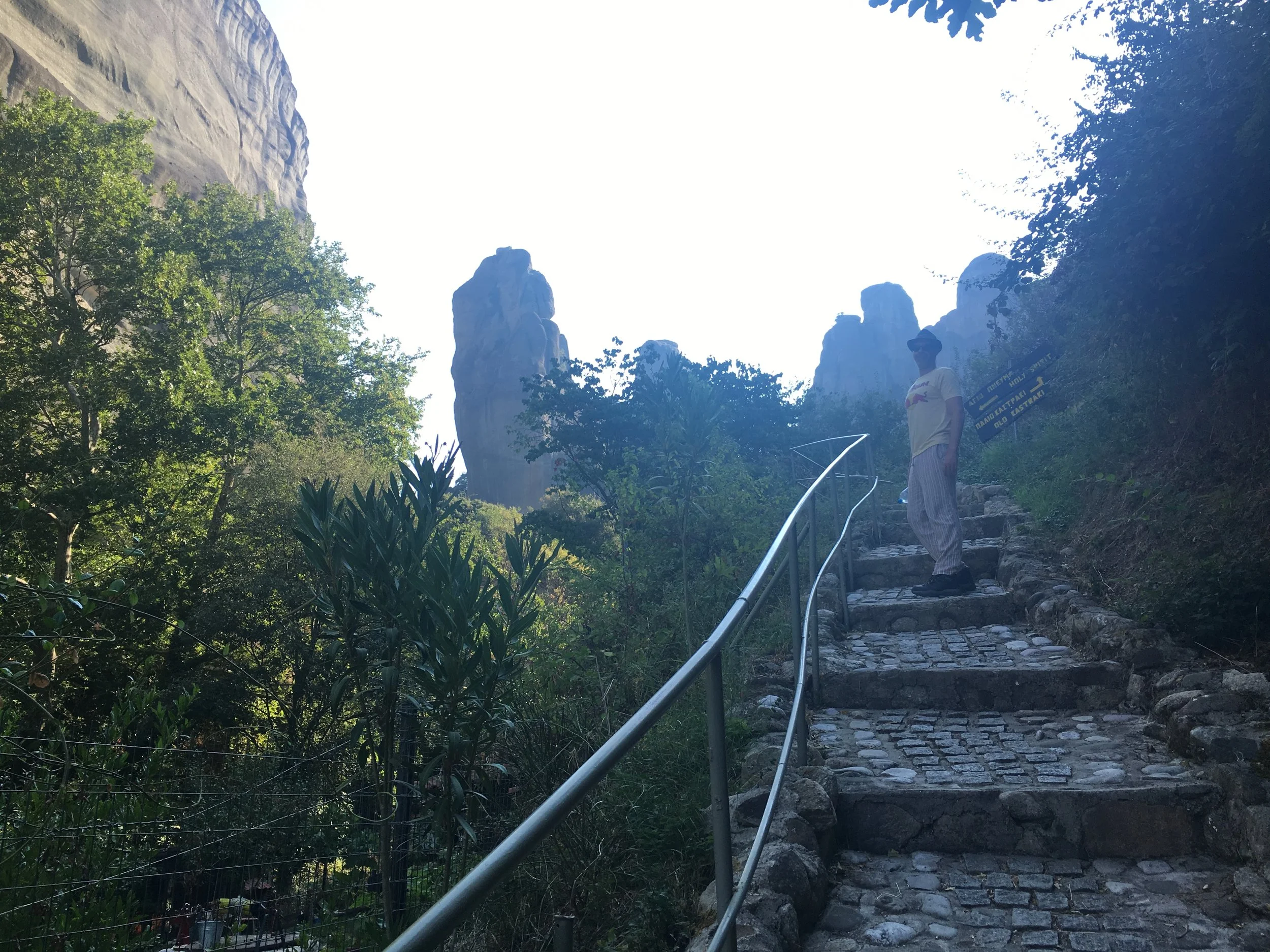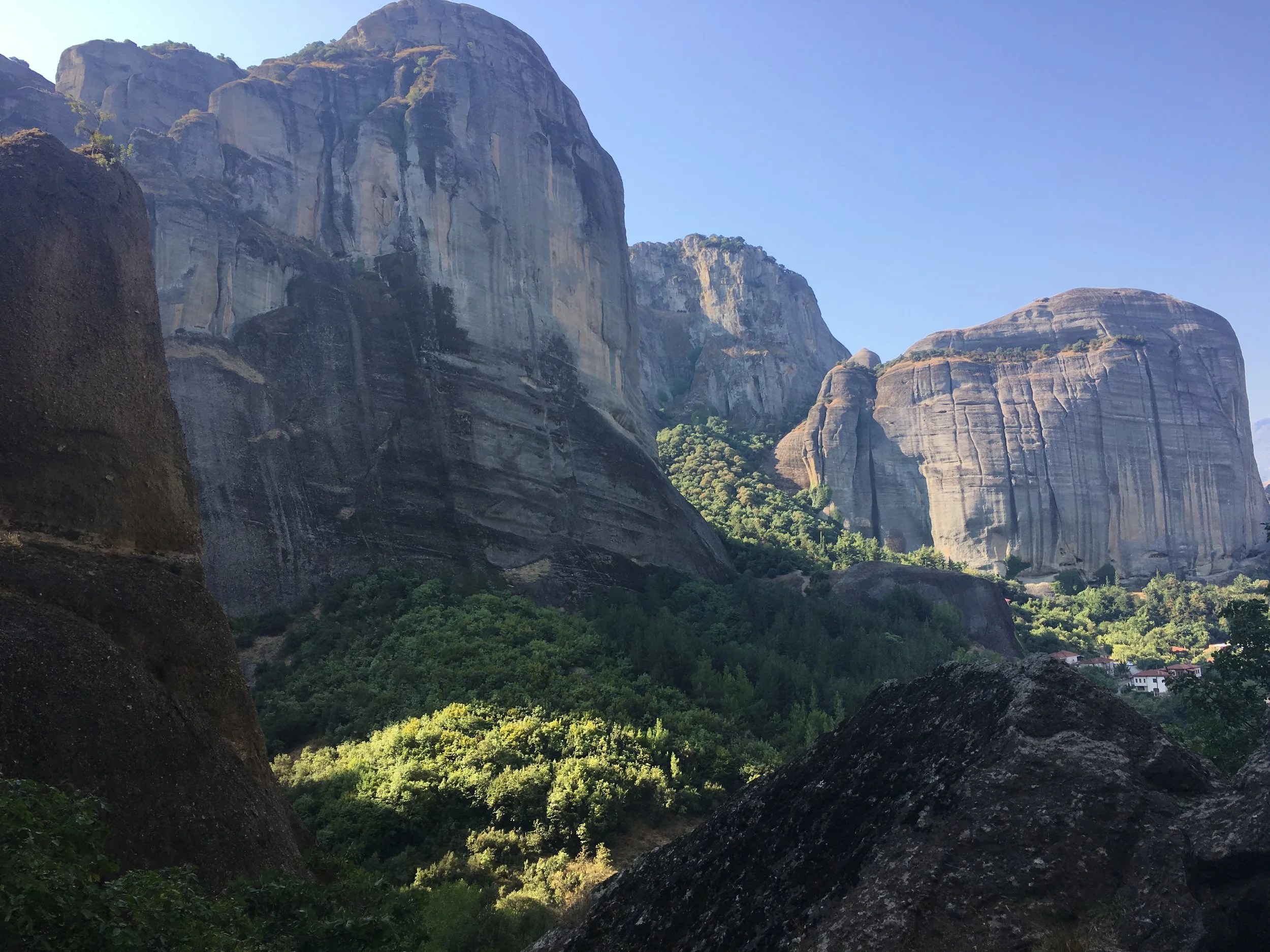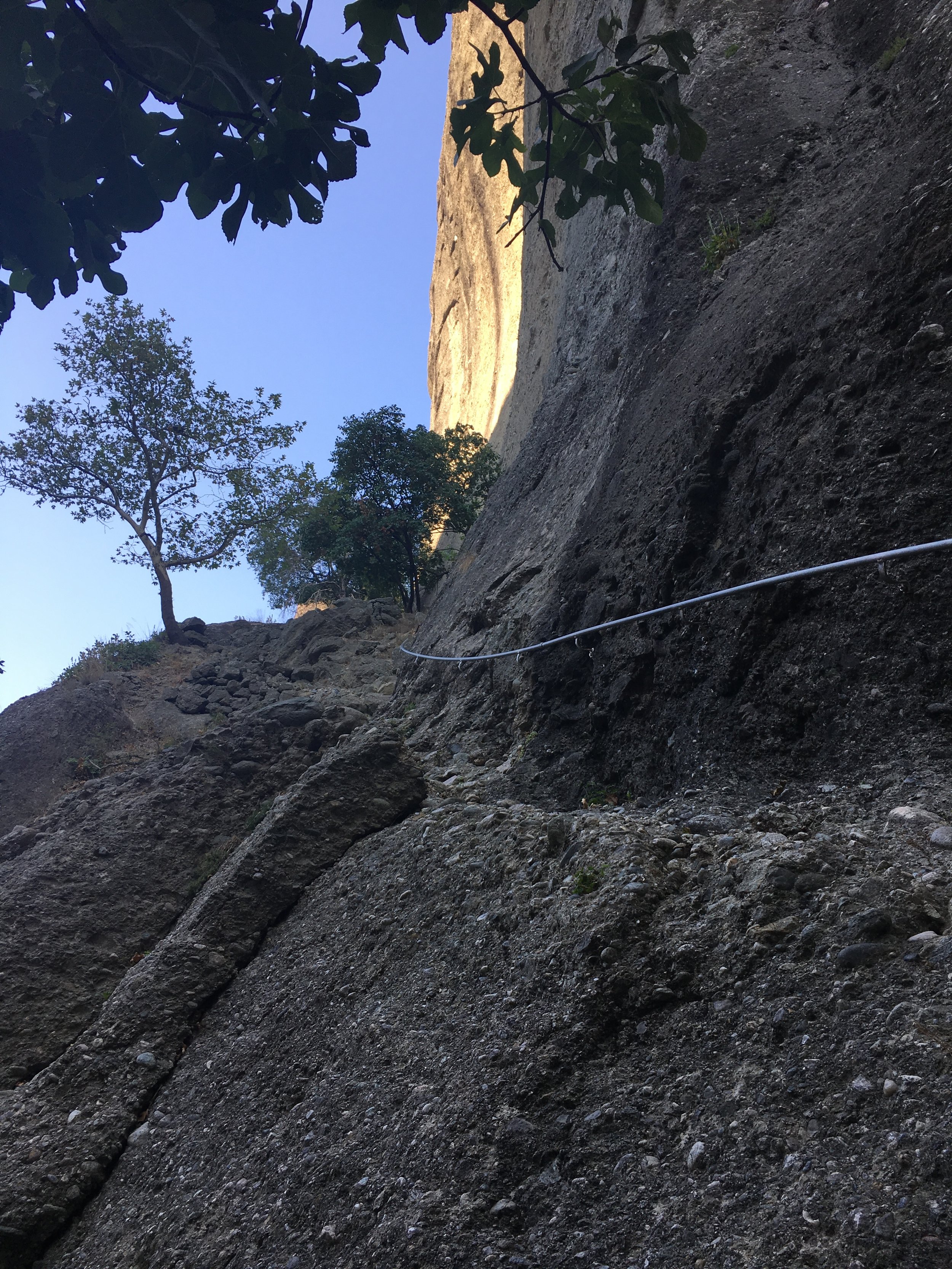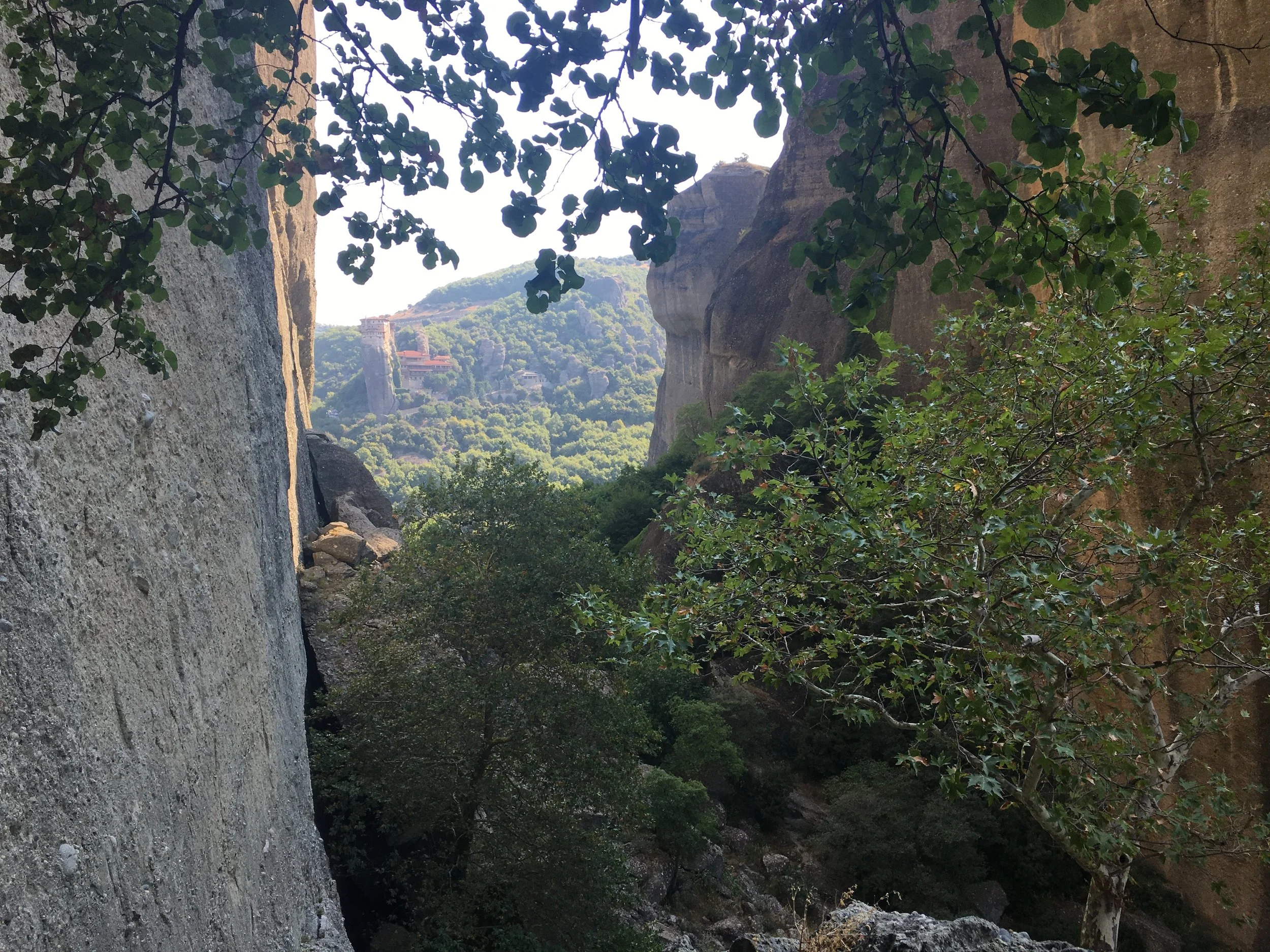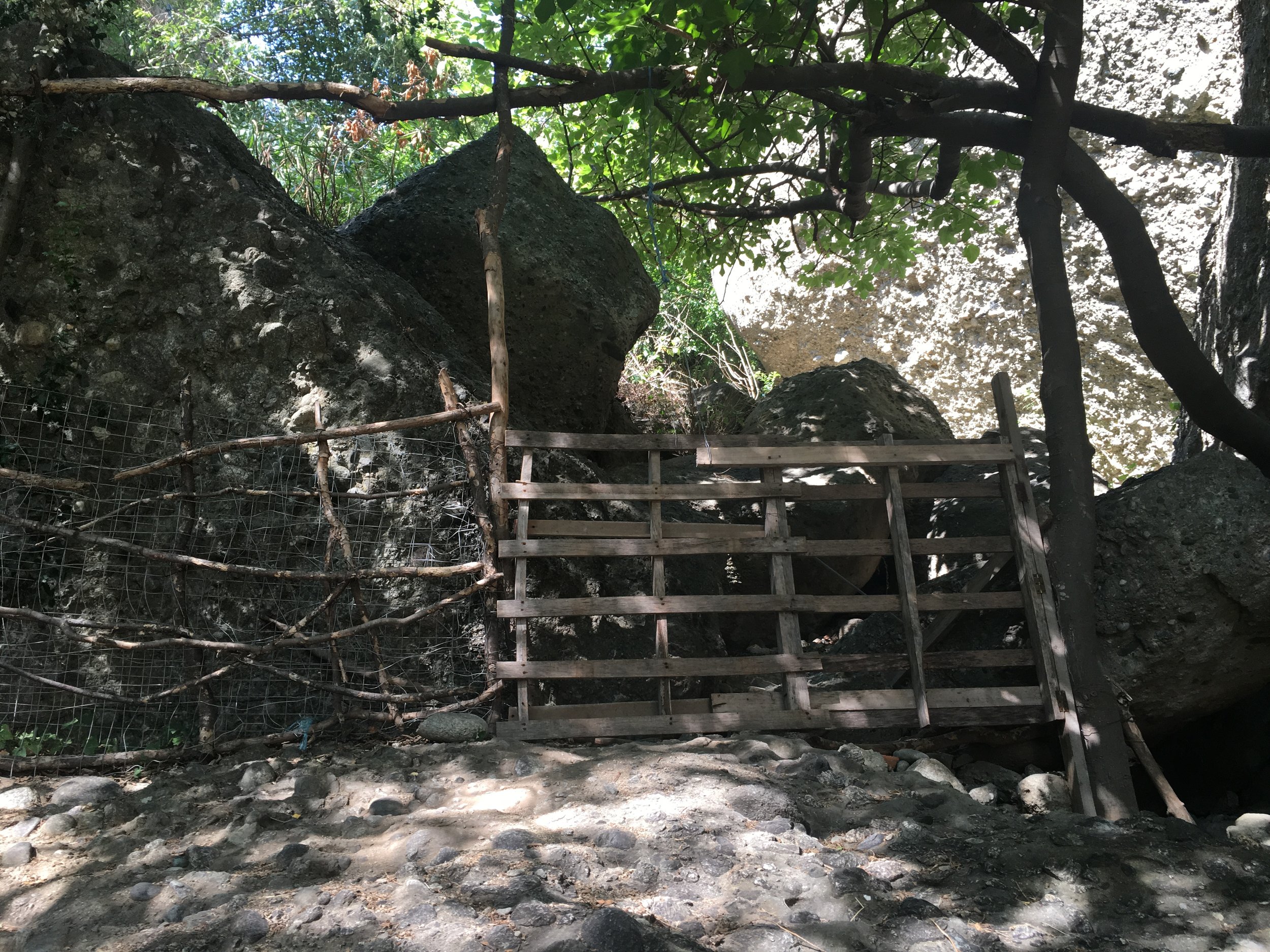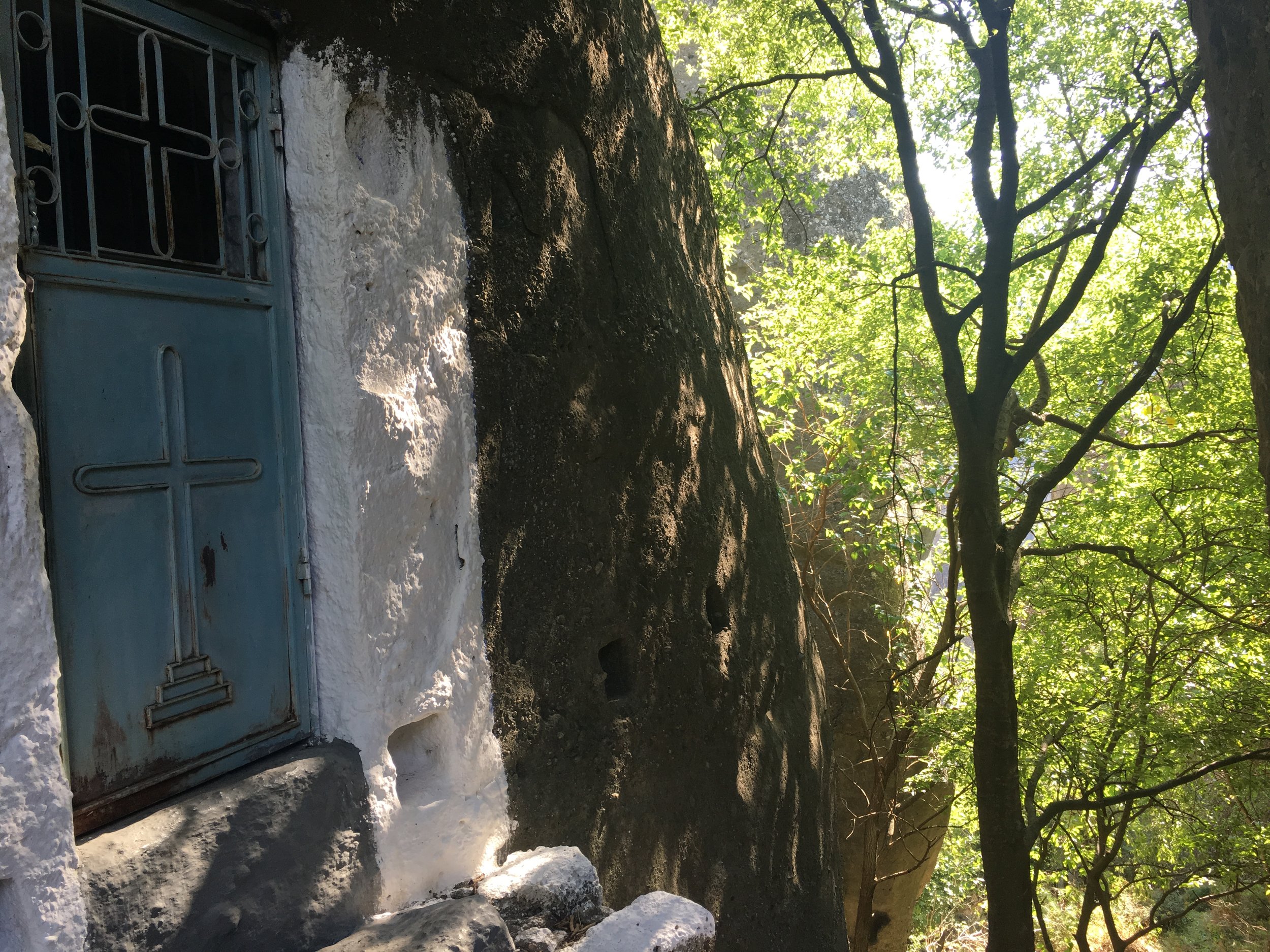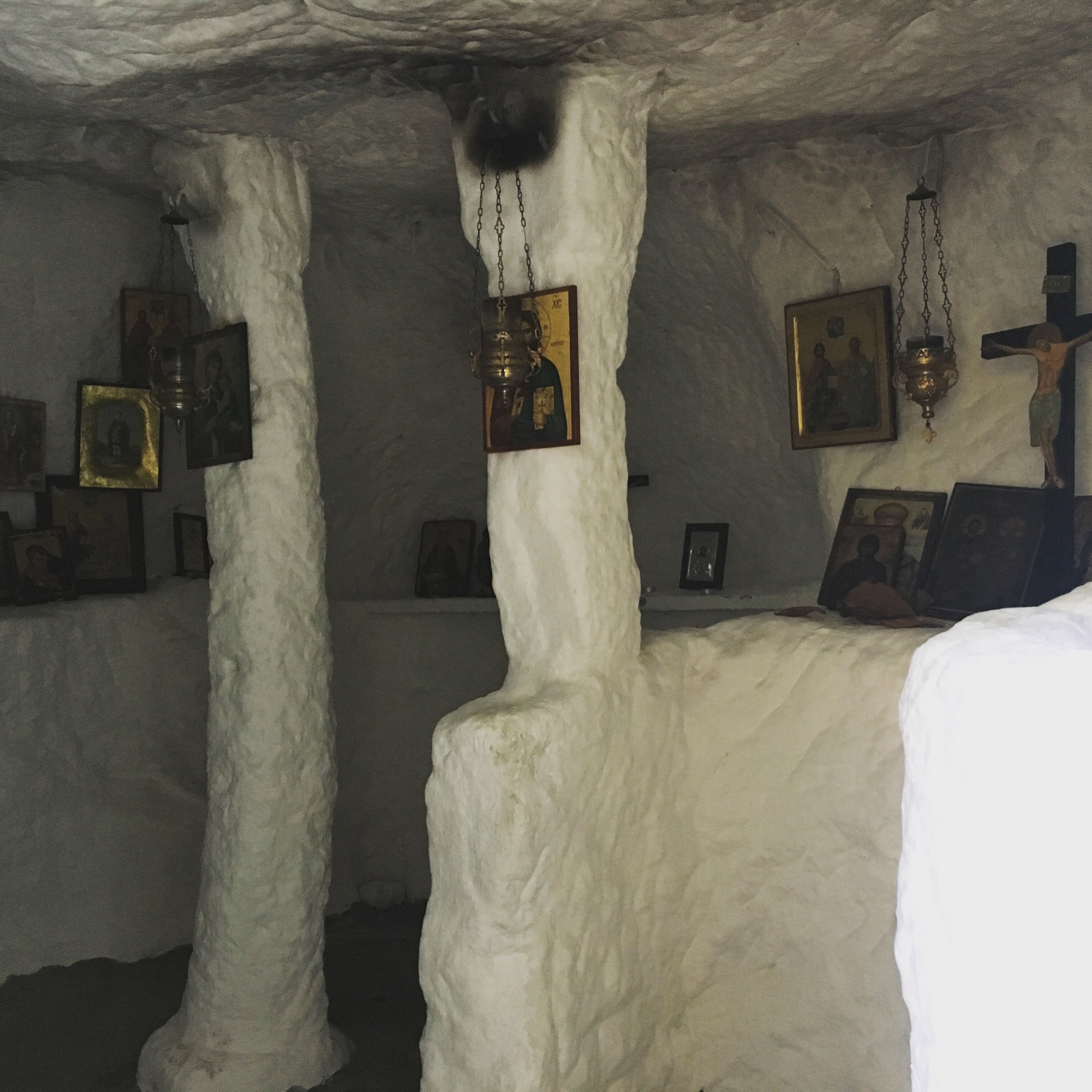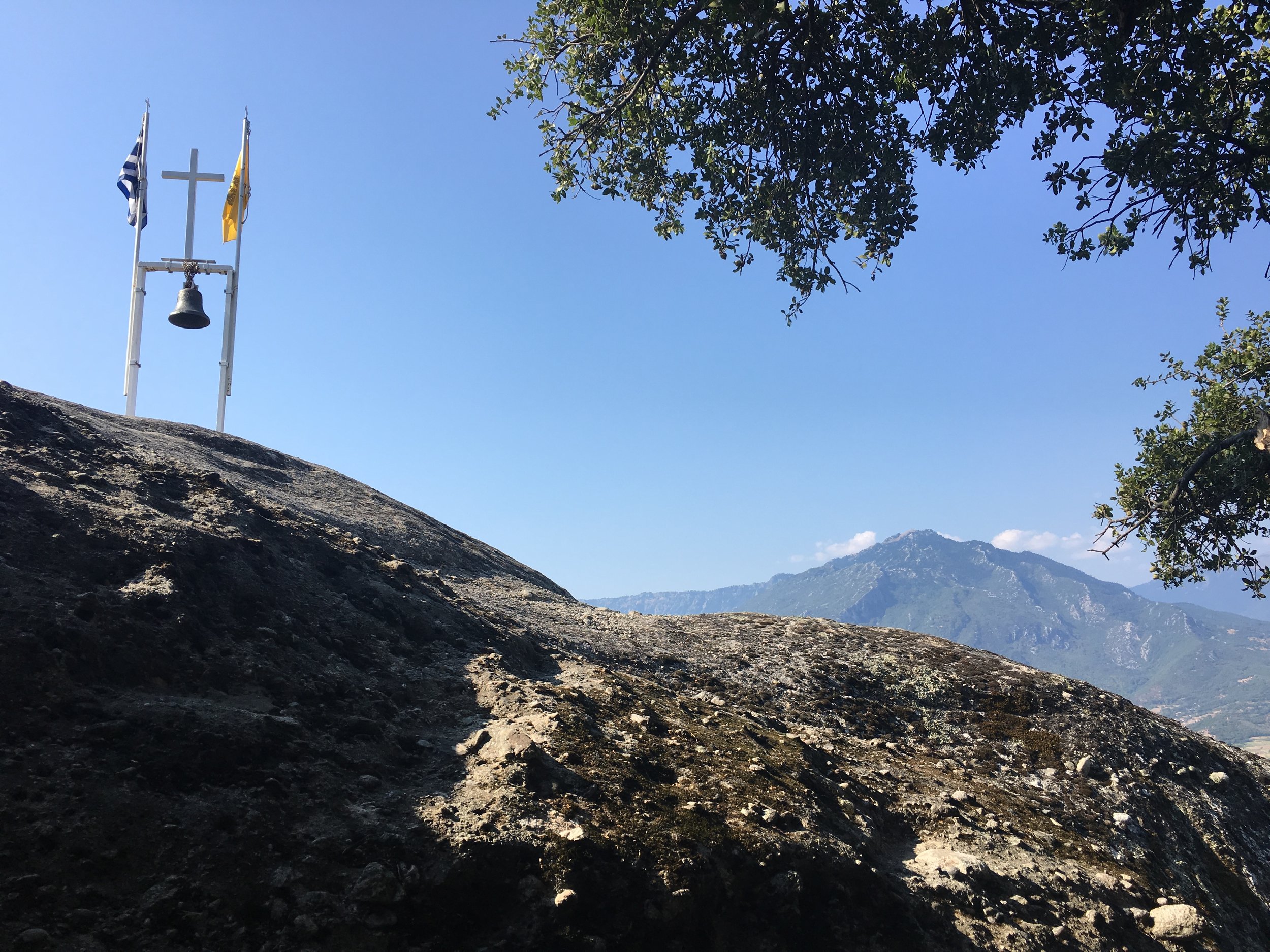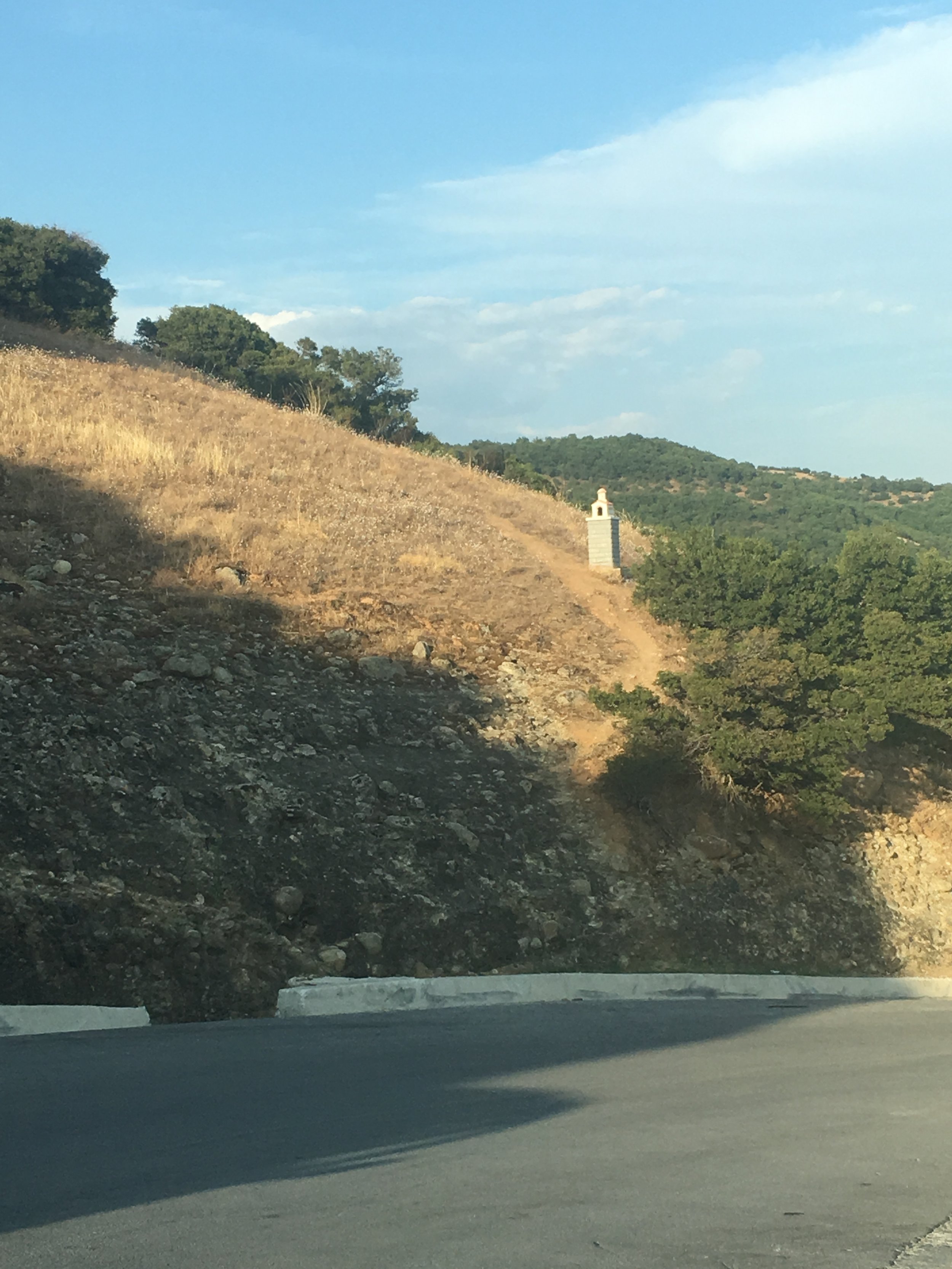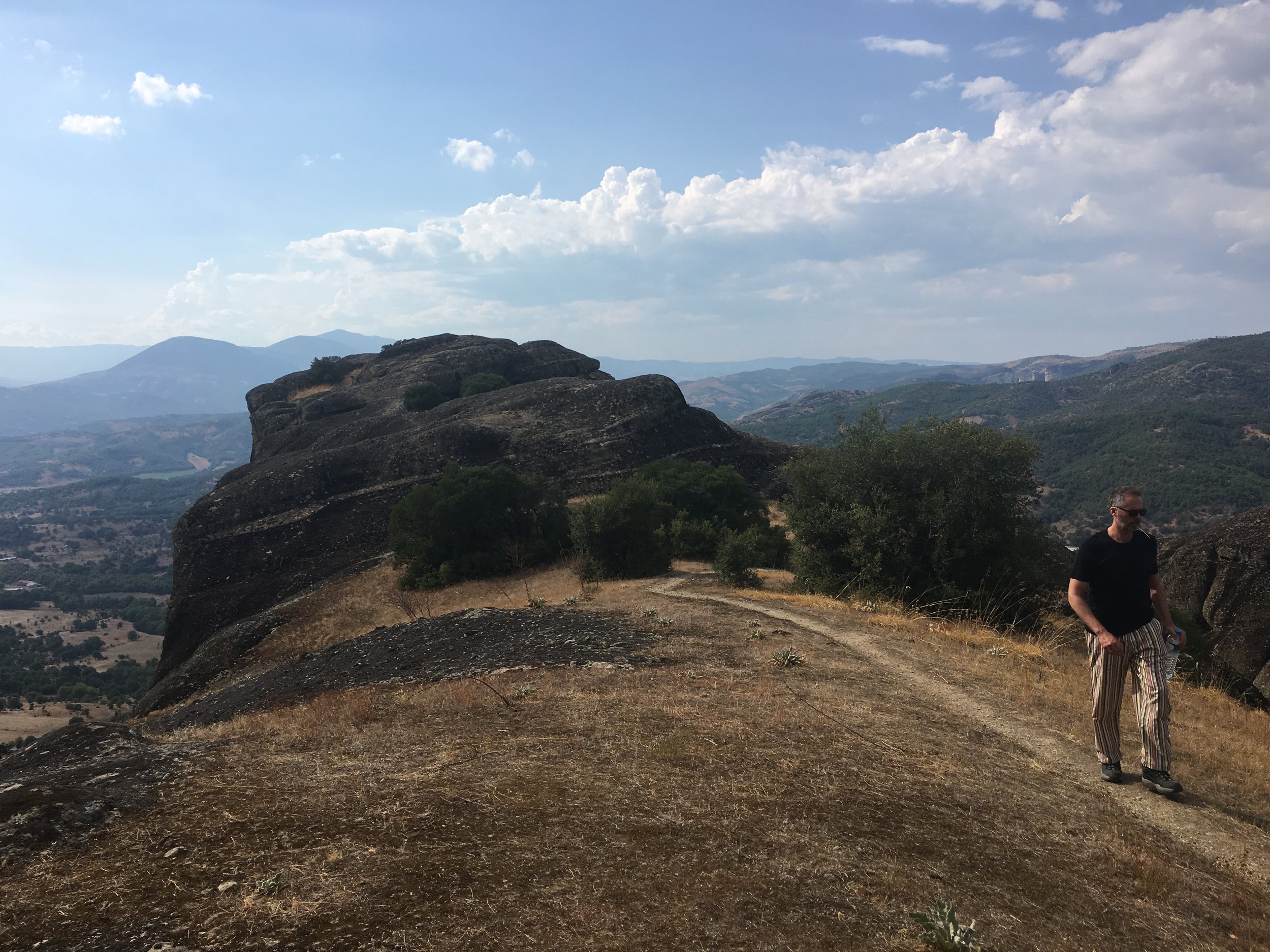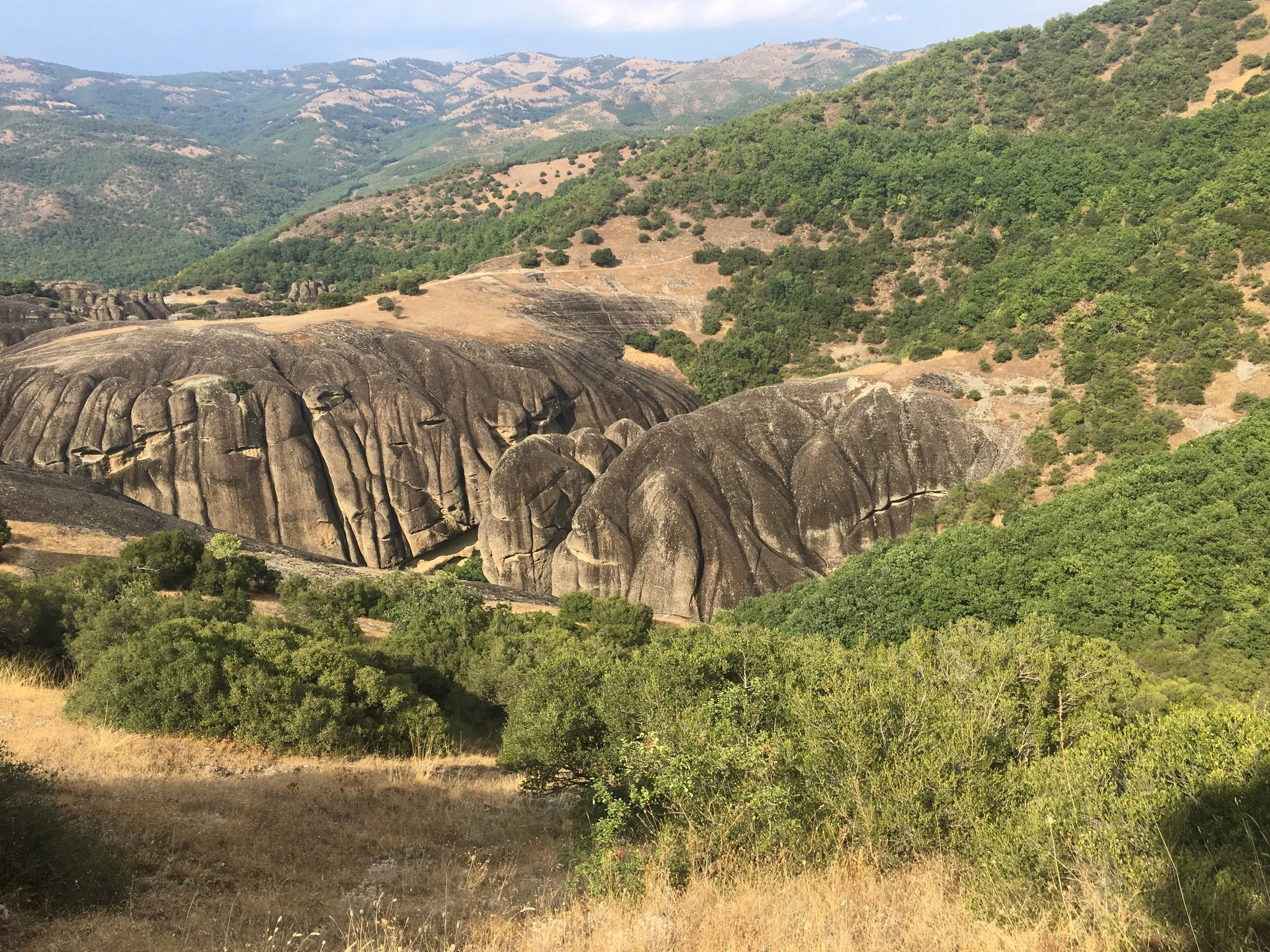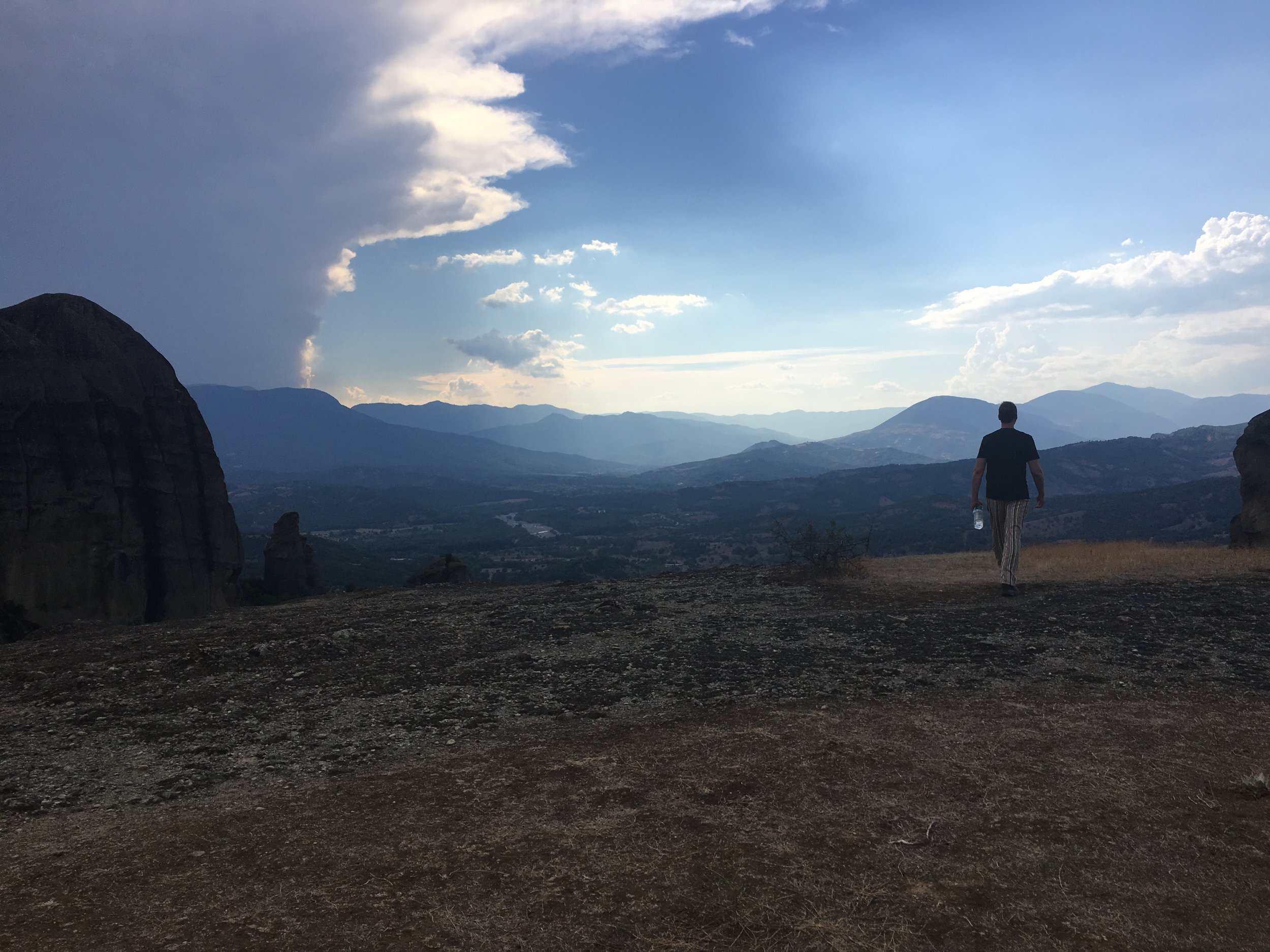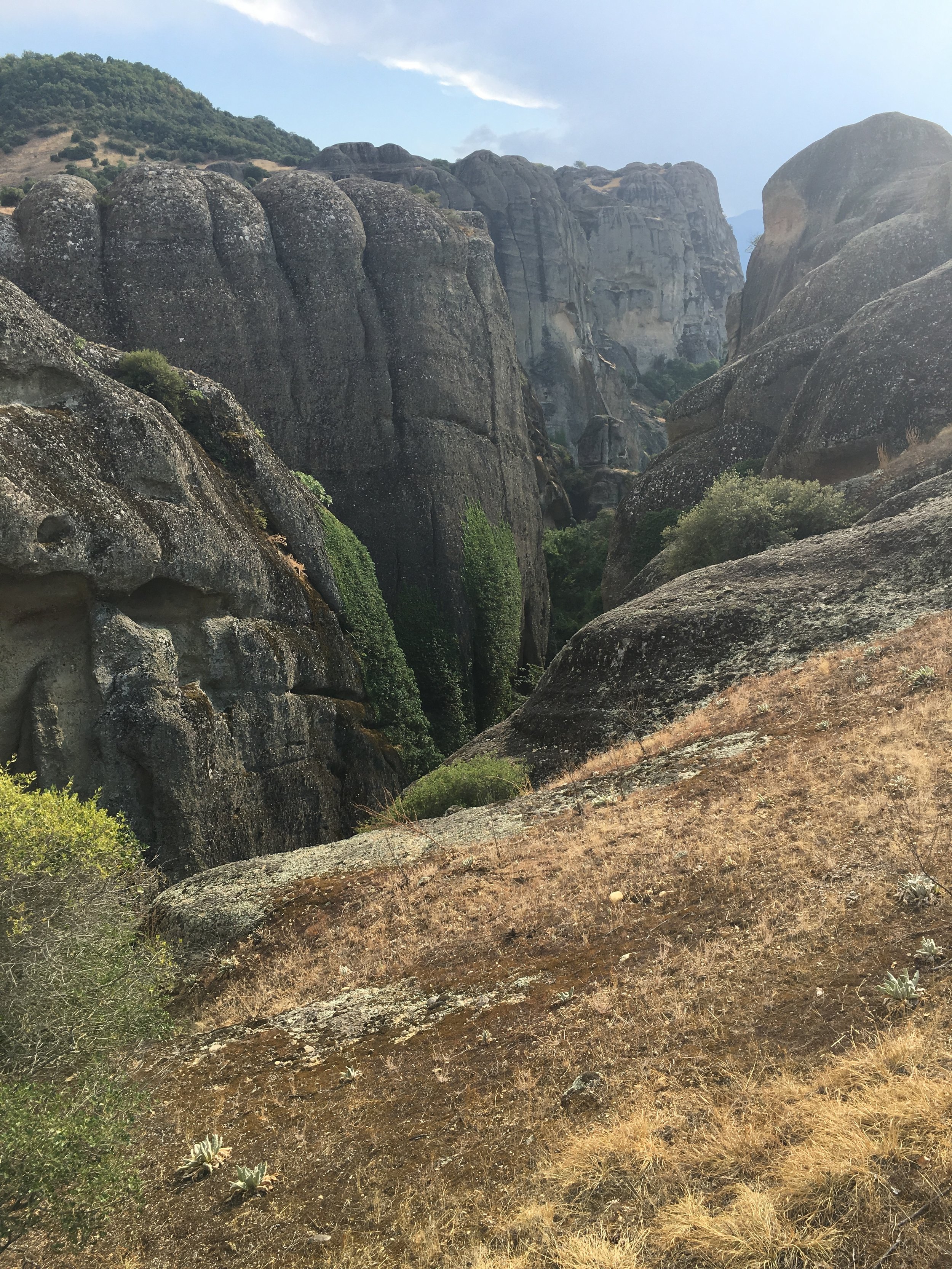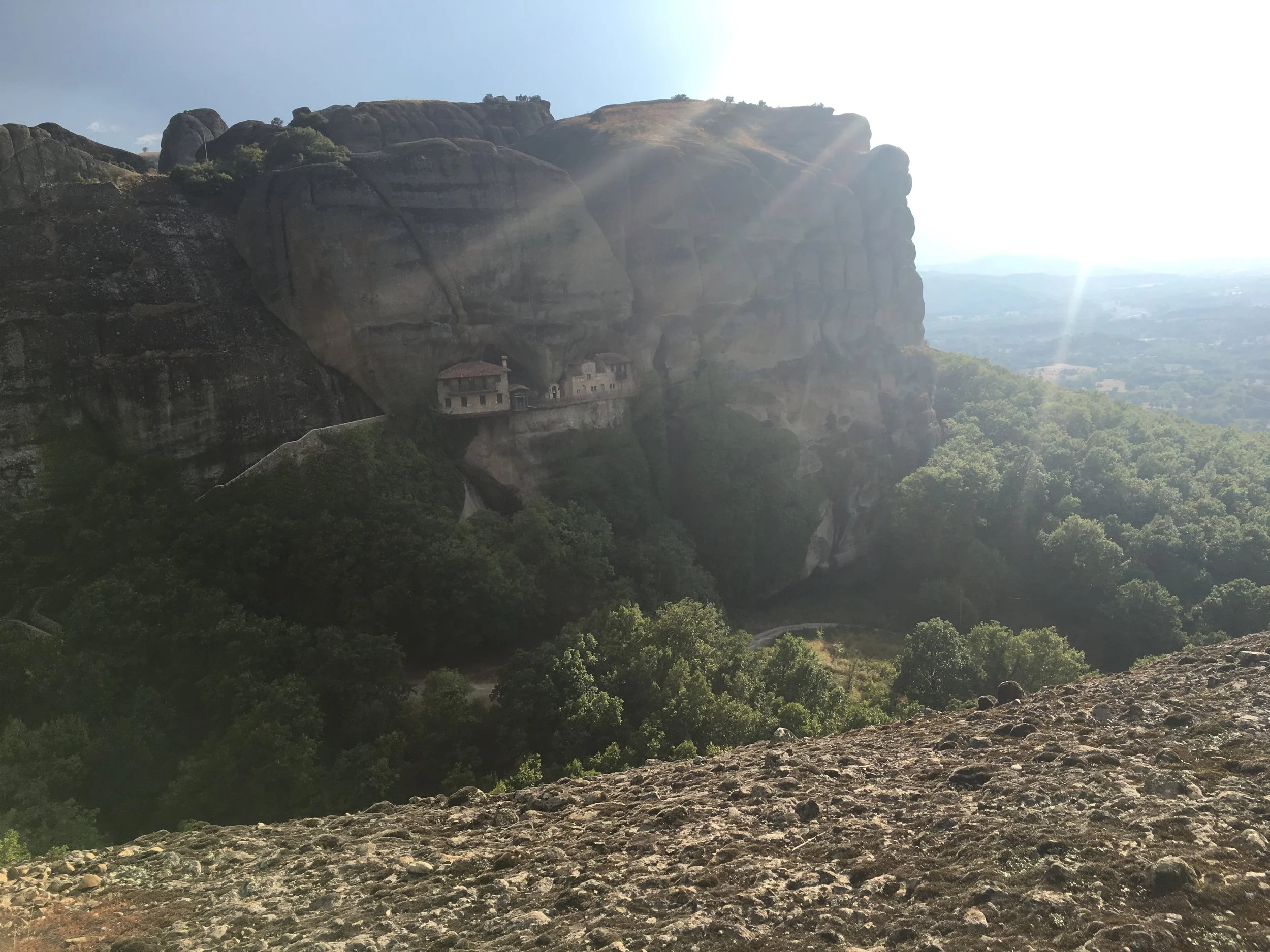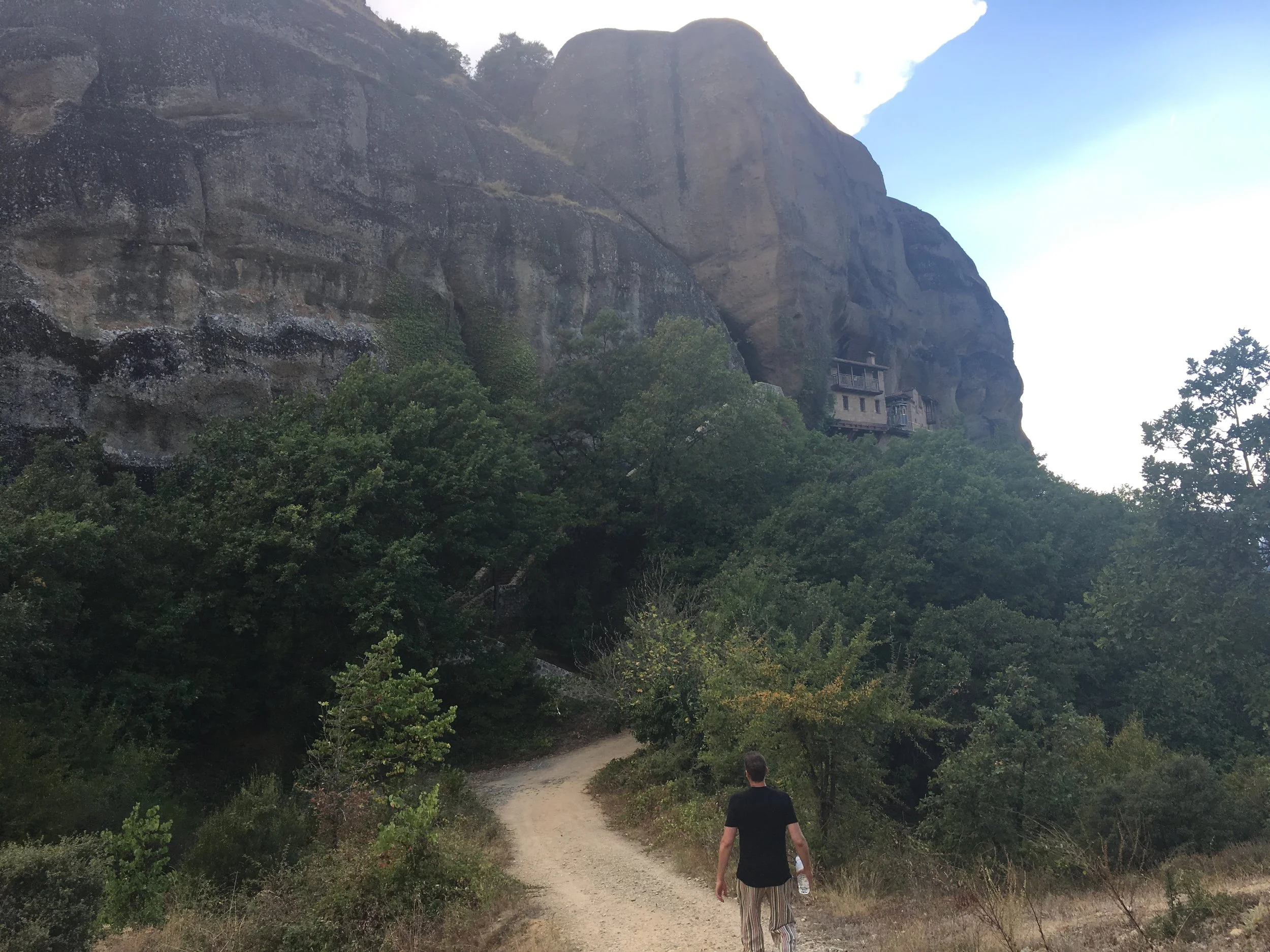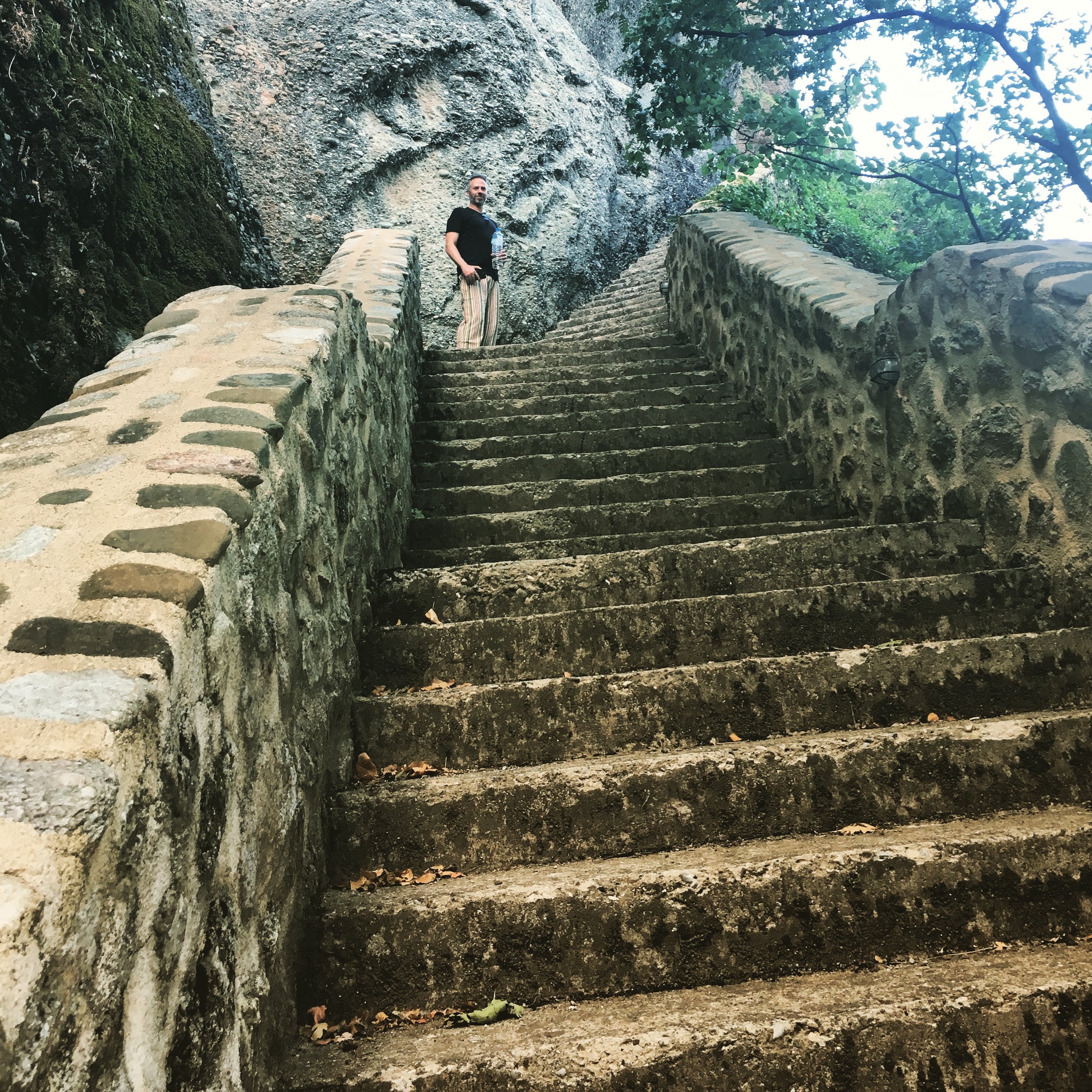Mainland Greece: Meteora, The Lost World
/Our third day in Greece we headed to Meteora (a day early because the forecast was predicting thunderstorms). On the way, we stopped in Morfovouni, a small village set along the steep slopes of a mountainside near Limni (lake) Plastiri. We hiked up to the top of the village from the church square below and then returned for lunch at Taverna Plastiras for roasted lamb and aubergine stew. Fantastic meal! We sat in the church square and watched a group of village boys playing football, using lampposts and trees as goalposts. As it was a Sunday afternoon, all the men in the village were gathered at the various cafes and taverns on the square to smoke, drink coffee and chat.
The drive from Lamia to Meteora alternated between gorgeous mountains and hills and extremely flat and frankly boring farmland. But because of the incredible views from the mountains, I think it is still well worth driving this way. Coming down out of the mountains we headed into a stretch of flat valley and in the distance, the towering columns of Meteora appeared.
The first of the villages in Meteora that we came to is Kalambaka. It is the larger of the two but only one monastery, Agia Trias, is visible from here.
Agios Stefanos
The smaller town, Kastraki, has the best views as it is nestled among the more impressive of the pillars. We were also told that Kastraki boasts the best restaurants as well.
The process that created these pillars is unique to only a handful of places which is why seeing this place is so breathtaking. Deposits of sand and stone deposited here over millions of years was pushed up into a plateau by earthquakes. It was crisscrossed by fault lines, which were then weathered away into the pillars now standing.
The place just feels ancient. To me, while of course the Eastern Orthodox monasteries that top some of the pillars are hugely impressive, it’s the geography itself that is the most incredible. Up close, the formations look a bit like concrete studded with pebbles and rocks. Each pillar has a name, often after the monastery it houses, which is very helpful in situating yourself on a map!
Kastraki
When searching for information about the human history of the area, it was quite difficult to find anything about the ancient civilizations of the area. It's as if that time here has been forgotten. I have read that the area was inhabited twice, once by Neolithic humans and then again in the 7th-9th century when the Greek monks began to build the infamous monasteries safely atop the towering rocks. However, there must have been some activity in between, because, as you will see later, a very famous church is built on the site of an ancient pagan temple dedicated to Apollo.
There are 13 monasteries in the area, but only 6 of them active today and inhabited by only a handful of monks and nuns. Some have fallen completely into ruin and others are simply out of use but completely intact. You can visit the active monasteries for a small fee. There are also quite a few very impressive hikes from both the villages below and the road above.
Hotel Meteora and Kastraki below
We stayed at the beautiful Hotel Meteora. This lofty hotel is perfectly situated just outside of Kastraki overlooking the village with an absolutely stunning view of the formations. I chose it because it had a pool and thinking it would be very hot after our hikes, I thought a dip would be perfect in the evenings. The setting is magical! My only complaints: the restaurant really wasn’t anything to write home about which is surprising anywhere in Greece, really. The food was rather bland. We only ate there because we were too tired to venture out and wanted to get to bed early to prepare for our hikes the next day. Also, the place was brimming with children. This is a great place for families so if you are looking for a romantic getaway in this place, Hotel Meteora during peak travel season probably isn’t for you! Other than that, I have nothing bad to say. The room was spacious and clean and from what I can tell, all of them have a view. The staff was very friendly and exceedingly helpful. The entire hotel is decorated with gorgeous black and white photography of the area and the monasteries.
Our first morning we helped ourselves to the free buffet at the hotel. We filled up our bottles with plenty of water and headed out with extra fruit to Kastraki. Our first hike started at the easternmost side of the town with the small church Agios (Saint) Nikolaos, not to be confused with the monastery atop a peak of the same name. This one sits nestled between the pillars Pixara and Surloti. We parked near the town square and headed in what we thought was the right direction. We could see the church above the houses so we had a general idea. We passed beautiful little houses and gardens along the way and then hit a dirt road that headed up the hill to the church. Here, the road splits, one heading up to the left will take you to Nikolaos and another church higher up, Panagia. The other, to the right, wraps around the rock formations taking you below inhabited caves or hermitages carved into the great rocks. Just after Nikolaos, the trail transforms from a dirt road to a wood beam staircase, taking you through the shady forest above. The darkness and tranquility reminded me very much of the temples of Japan.
We climbed past the two churches and up into the large crevasse between the Agiaapostoli and Alissos. I had two conflicting maps - one had a trail, the other did not. Passed the base of the smallest, standalone pillar, Adrachti, we decided to push on but what I thought were trails, I now think might have just been naturally formed waterways. I’m still glad we went this way. Through the rocks, you can see Kalambaka below and above, the swooping swallows calls bounce off the rocks. You feel as though back in another time entirely. We hiked up a steep incline that led us back past Adrachti. It was a hell of a climb but really fun and great exercise!
As we headed back down the hill a little cat joined us for the walk and followed us practically back to the village. Our plan had been to go to Kalambaka and hike to Agia Trias from there but after a quick conversation with a local woman, Dino determined that we could do a hike we previously thought might have been too difficult: Agion Pnevma (Holy Ghost), the giant formation towering above the middle of Kastraki. Every year, she told us, the entire town hikes this rock on the festival day celebrating the Holy Ghost. If old women and children can do it, so could we, she told us. So we headed through town and followed signs to the head of the next trail.
Just below “Old Kastraki” you will come to a spring and a trailhead. Fill up with the fresh spring water before you start your climb! We reached this trail at 9am but were still sweating profusely when we reached the top of the rock. If you love hiking or are in relatively decent shape, you can do this hike without a guide. It is almost completely uphill on the way up and sometimes so steep, the locals have fitted rails to the sheer rock walls to help hikers on their way. About a third of the way, we reached a large crevasse through which Roussanou nunnery could be seen in all its glory! It’s made up of two large buildings on a outcropping of rock high above the villages. Further up, the trail led us through the two formations that make up Agion Pnevma. About halfway up we came to a rustic wooden gate. We couldn’t tell what it was designed to keep in (or out?). A short time later we came to the opening of a tree filled plateau between the two rocks. Here, unless you have rock-climbing gear, is the end of the hike. We came to a beautiful blue wooden door that opened into a white-washed cave full of votives. From down below we could see a cross and two flags at the very top of the formation. You can get to this area but you will have to use the boulders and trees to get there. I was too afraid I would not be able to get down, so I skipped it. My husband did climb up and assured me the view was incredible. I didn’t doubt it! We had a snack looking out over the village below before heading back down and back to the hotel for a nap. We crashed! These hikes are physically demanding and require the right footwear for a comfortable climb. After a couple of hours, we headed out again for our final hike of the day.
We drove up to Megalo Meteora, the largest of all the Meteora monasteries for the final hike of our stay. The rock formations stretch out behind the main cluster along, what I felt to be the most impressive of all the views. A short way down the hill from Megalo, you will see a very small path on your left marked by a small church sculpture. From here, walk up the hill and take the path to the left for the longer walk or straight on for the shorter hike to your final destination, the hero statue and Ypapanti monastery. The long way takes you along beautiful golden fields and along the edge of formations that you can climb out onto to see the spectacular views of the valley below and the towering mountains across the river. You then descend through forest to get to the beautiful and now unused cliffside monastery, Ypapanti. I literally stopped in my tracks and gasped when it came into view. Its location seems so impossible – so precarious! At first glance, it looked as though the place was only accessible by rope, but as we got closer, we saw a steep stone staircase leading up and a small manual elevator. You can climb the stairs but it only took us to a large (locked) iron door in the rock. Still it was amazing to see up close!
We then trekked over to the hero statue and then made our way back, opting for the short cut back as at this point we had hiked about 10 miles and were exhausted!
That night we returned to the hotel to freshen up and then made our way to Meteoron Panorama restaurant (meteoronpanorama.gr) for a drink. Once there, we were totally charmed by the beauty of the place and decided to stay for dinner. Situated between Kastraki and Kalambaka, the sprawling terraces of the restaurant sit directly underneath the cluster of pillars from our first hike that morning. And, unlike the other rocks, they benefit from some up-lighting so you can see them from the restaurant in the evening and at night. We ordered mushrooms stuffed with anthotiro cheese and herbs, roasted lamb and lamb chops paired with Hatzimichalis Cabernet Sauvignon that ended up being my favorite wine from the trip and only €12.50 a bottle in duty-free! The food was excellent and the view spectacular. I definitely recommend this place for anyone visiting the area!
Incredibly, on all of our hikes that day, we didn’t meet a single other person along the way. Tourists seem to drive to see the monasteries but fewer venture out along the hikes. It makes for an even more mystical and magical experience. One warning: the wasps! We were harassed along the entire final hike with wasps darting towards are heads and faces. I was constantly swatting them away with flailing arms and ducking out of their way. To be fair, I am not a fan of flying insects and my time in big cities has totally sensitized me to their presence.
The next day we headed to Kalambaka for some lunch and a wander. We stopped in at Meteora Restaurant for some delicious food. Situated on the square, you will find traditional Greek fare. It has been family owned and operated since 1925.Here I had aubergine salad, beet salad with yogurt and saganaki, or fried cheese, this one with sesame seeds. Delicious!
We then hit up a local shop for some souvenirs and I snagged some great sandals! We then walked through the town up the hill to find the Byzantine church at the foot of Agia and Alissos. Built on a previous ancient temple dedicated to Apollo, the date of origin of the Orthodox Church is now disputed. Erected as early as the 7th century, the church is most notable for the 15th century frescoes that cover its walls. Photography inside is strictly forbidden but the attendants are happy to give you a tour.
I wanted to go on so many more hikes but we had to press on to our next destination. I will visit Meteora again. It was an absolutely magical place! If you love hiking, there are so many wonderful places to explore!











